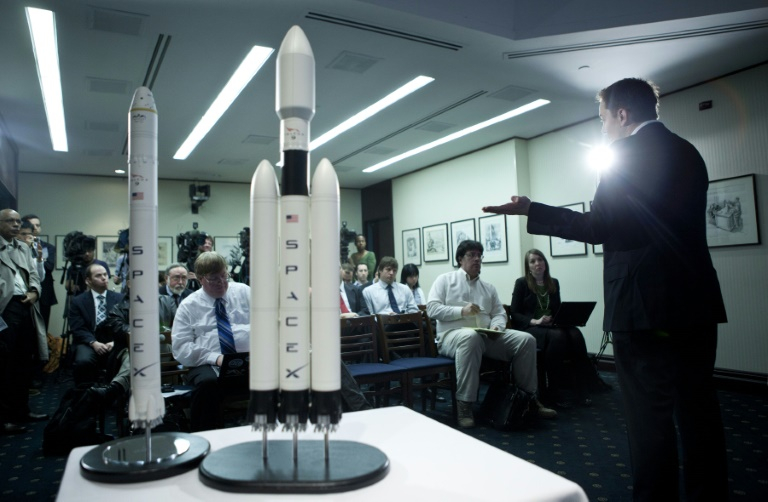
SpaceX’s Elon Musk presents the model of the company’s Falcon Heavy rocket in 2011, the real version of which was test-fired January 24, 2018. Image: Brendan Smalowski / Getty/AFP
SpaceX on Wednesday test-fired its Falcon Heavy rocket for the first time in a launch pad experiment aimed at giving its main engines a trial workout before blasting off in the coming days.
Touted as the “world’s most powerful rocket,” the Falcon Heavy is designed to one day carry crew and supplies to deep space destinations such as the Moon and Mars.
“Falcon Heavy hold-down firing this morning was good. Generated quite a thunderhead of steam,” SpaceX chief executive officer Elon Musk wrote on Twitter.
“Launching in a week or so.”
The Falcon Heavy is essentially three of the California-based company’s Falcon 9 rockets put together, with 27 Merlin engines instead of nine.
Wednesday marked the first time SpaceX fired all 27 engines at once.
“First static fire test of Falcon Heavy complete — one step closer to first test flight!” SpaceX wrote on Twitter.
A date for the launch has not yet been revealed.
On its maiden voyage, the Falcon Heavy will be loaded with Musk’s own cherry red Tesla roadster as it aims for an orbit around the sun.
The orbit should be about the same distance from the sun as Mars, but would not take the rocket very close to the Red Planet.
That is, if the rocket makes it that far.
“Will be in deep space for a billion years or so if it doesn’t blow up on ascent,” Musk, the famed space enthusiast and Internet tycoon, said on Twitter last month.
In an interview with astronomer and blogger Phil Plait, Musk went even further.
“Just bear in mind that there is a good chance this monster rocket blows up, so I wouldn’t put anything of irreplaceable sentimental value on it,” he was quoted as saying. AB
RELATED STORIES:
SpaceX launches secretive Zuma mission
Thirsty rocks may contain the missing water of Mars
Pentagon acknowledges secret UFO-hunting program